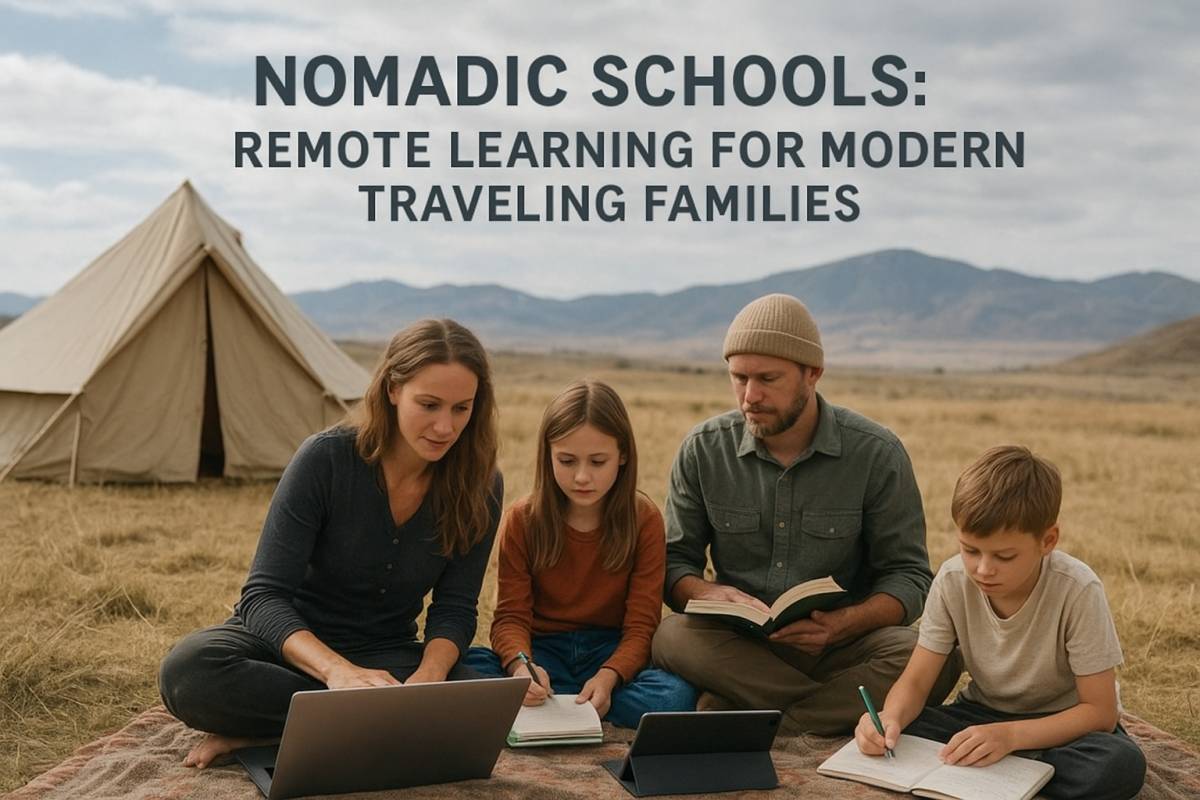Nomadic Schools: Remote Learning for Modern Traveling Families

Nomadic schools are remote learning systems designed to help traveling families provide consistent, quality education to their children while living on the move. Instead of being tied to one physical classroom, kids access lessons online, connect with teachers virtually, and engage with peers worldwide. This model ensures education keeps pace with travel, offering freedom without sacrificing learning.
What Are Nomadic Schools?
Nomadic schools refer to educational setups where the curriculum, teachers, and resources are accessible online, allowing children to learn from anywhere in the world. These schools are designed for families who embrace mobility – digital nomads, full-time travelers, or expats—ensuring their kids stay academically aligned with global standards.
- Flexibility – Classes adapt to time zones and family schedules.
- Accessibility – All learning materials are digital and cloud-based.
- Global Perspective – Students connect with diverse peers.
Why Are Nomadic Schools Growing in Popularity?
1. Rise of Remote Work and Digital Nomadism
With remote work becoming more common, families no longer need to settle in one location for job opportunities. Parents working online can travel while maintaining their careers, and nomadic schools ensure their children’s education keeps pace.
2. Desire for Real-World Learning Experiences
Many traveling families value experiential learning. Instead of learning history from a textbook, children can explore ancient ruins in Europe or participate in local cultural festivals in Asia, making lessons immersive and memorable.
3. Continuity in Education
Frequent relocations can disrupt traditional schooling. Nomadic schools provide a consistent educational path that prevents gaps in learning and keeps children academically on track.
4. Exposure to Diversity
Being part of a global online classroom exposes children to different cultures, languages, and perspectives, nurturing empathy, open-mindedness, and adaptability—skills increasingly important in the 21st century.
Key Features of Nomadic Schools
- Virtual Classrooms – Live or recorded sessions led by certified teachers.
- Customizable Curriculum – Parents can select international standards like IB, Cambridge, or U.S. Common Core.
- Project-Based Learning – Lessons often tie into travel experiences, making learning practical.
- Community Support – Online groups for parents and students create social bonds.
- Tech Tools – Platforms use apps, AI tutors, and collaborative whiteboards to make learning interactive.
Benefits for Traveling Families
1. Education Without Borders
Children can continue their learning journey regardless of location, whether in urban centers, remote islands, or on the road.
2. Flexible Scheduling
Families can design study schedules around sightseeing, family activities, or seasonal travel. This flexibility allows learning to fit seamlessly into a traveling lifestyle.
3. Exposure to Global Cultures
Children gain firsthand experience of different cultures, languages, and traditions, enriching their education beyond textbooks.
4. Cost-Effective Learning
Compared to international schools or private tutoring abroad, nomadic schools are often more affordable, providing access to quality education without massive fees.
5. Active Parent Involvement
Parents are more engaged in their child’s learning journey, helping with assignments, monitoring progress, and creating customized educational experiences.
Challenges of Nomadic Schools
While beneficial, nomadic schools also present hurdles:
- Time Zone Conflicts – Live classes may clash with travel schedules.
- Socialization Concerns – Some parents worry about reduced face-to-face interaction.
- Internet Dependence – Remote learning requires stable connectivity, which isn’t always available in rural or off-grid destinations.
- Self-Discipline – Students must develop independence and focus outside a traditional classroom environment.
How Parents Can Make Nomadic Schooling Successful
- Create a Learning Routine – Set consistent daily or weekly schedules.
- Use Travel as Education – Turn cultural visits into history lessons or nature trips into science projects.
- Stay Connected – Join online communities of traveling families to share resources.
- Invest in Reliable Tech – A good laptop, noise-canceling headphones, and backup internet solutions are essential.
- Balance Screen and Real-World Learning – Encourage outdoor activities and real-life interactions alongside online studies.
Examples of Nomadic School Models
- Virtual International Academies – Accredited institutions offering full K–12 programs online.
- Micro-Schools on the Move – Small groups of families pooling resources to hire traveling teachers.
- Hybrid Nomadic Learning – Mixing online schooling with local cultural workshops or temporary on-site classes.
The Future of Nomadic Schools
Nomadic schools are more than a short-lived trend—they represent a shift in how families view education. As remote work becomes mainstream, global mobility will grow, making borderless schooling increasingly necessary. AI tutors, VR classrooms, and immersive global projects could redefine what “school” looks like for the next generation.
Conclusion
Nomadic schools are transforming education for modern traveling families, ensuring children receive high-quality learning while exploring the world. They bridge the gap between academic consistency and the freedom of a nomadic lifestyle. For families committed to adventure and knowledge, they represent the perfect balance of learning without borders.









